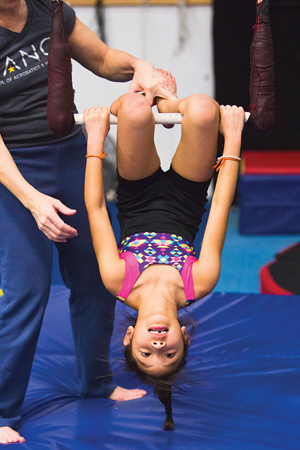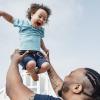
Earlier this year when Ringling Bros. and Barnum & Bailey Circus gave its final performance after a century as the “Greatest Show on Earth,” generations of traveling circus fans mourned as the flying trapeze came to rest a final time. But the reimagination of circus arts was already well underway.
In cities across America, the trapeze still flies high from the rafters, but instead of seeing it under a big top, you’ll find it in converted warehouses and gymnasiums. Jugglers toss pins and spin plates, tightrope walkers practice their balance and unicyclists pedal their new talent. Today’s circus is more than quirky entertainment; it’s about inner and outer strength born through cooperation and community.
In the new circus, children aren’t spectators — they’re in the ring and on the ropes. For many, learning their first backflip on the mats or attempting their first catch on the trapeze means facing additional obstacles. Some are working through trauma or dealing with homelessness; others live with partial paralysis or are on the autism spectrum. The circus doesn’t care. Here, all kids have an opportunity to build resilience and trust in a noncompetitive environment. They can embrace and accept their differences rather than hide them.
“The circus is a highly encouraging environment. There’s never any winning or losing, and it can do wonders for your self-esteem,” says Jenny Mae Miller of West Seattle. For three years, Miller has practiced trapeze and aerial acrobatics alongside her daughter Marlene at Emerald City Trapeze. In that time, she’s seen Marlene’s physical strength and confidence soar.
Where to join the circus
Portland Juggling Festival is the largest regional juggling festival in the U.S., held every October on the campus of Reed College in Portland, Oregon. Beginners, hobbyists and pros of all ages participate in workshops on stilt walking, ball tricks, baton twirling and more. portlandjugglers.org
The Circus Project in Portland works with homeless and at-risk youth, tapping into the healing power of the circus to teach critical life skills, core strength, balance, trust and social cooperation. thecircusproject.org
The American Youth Circus Organization is a nonprofit that promotes the participation of youth in circus arts. It reaches more than 10,000 kids and young adults across the country.
I can relate. My 9-year-old son, Isaac, is on the autism spectrum; he faces challenges with social skills, resilience, anxiety and muscle tone. Several months ago, I began to explore how circus arts may help him focus on a new skill and build a healthy foundation for physical activity and mindfulness. That’s when we learned about the School of Acrobatics and New Circus Arts (SANCA).
A nonprofit dedicated to improving the mental and physical health of children of all ages through acrobatics and circus arts, SANCA is based in a palatial indoor circus space in Seattle’s Georgetown neighborhood. The warehouse includes two brightly lit gymnasiums full of cushioned mats, trampolines, tumble tracks and circus props. There are balance beams, Cyr wheels, rolling globes and unicycles.
Flying and static trapezes, fabrics, curtains, ropes and aerial hoops hang from the rafters. A side room for tots is equally spacious and ensconced in an orange-and-white-striped circus tent. The best part? Hearing the laughter and seeing the smiles of climbing, flying, tumbling children.
About 900 kids come here every week to practice circus arts. Accessibility for everyone is a guiding principle at SANCA. Scholarships go to about one-fifth of students, and the organization says it’s never turned anyone away for lack of funds.
SANCA also runs the Every Body’s Circus (EBC) program. EBC currently serves 50 kids with special needs ranging from blindness to autism, ADHD to hemiparesis (weakness on one side of the body from a stroke). Most of the students receive one-on-one instruction customized to their needs, interests and goals.
“We don’t assume anything about anyone,” says Alex Clifthorne, therapeutic circus arts manager for SANCA. “We meet kids where their needs and goals are and teach them the skills they want to learn.”
In her six years with SANCA, Clifthorne has seen children who are wheelchair-bound use the trampoline and hold onto the trapeze. She’s known visually impaired children who fly on the trapeze and walk a tight wire. One child with spina bifida gained enough strength in his arms and abdominal muscles to do handstands and cartwheels.
In many ways, circus arts seem almost tailor-made for kids like my son, who is a pervasive sensory seeker. Balancing on the tightwire or a rolling globe stimulates the sensory system, improving balance, core strength and control. The noncompetitive environment encourages self-paced learning and helps kids gently let go of fear of failure.
“Circus is such a sensory experience,” Clifthorne says. “It can feel really positive for these kids.”
Three more to exploreWhat does it feel like to defy gravity? Kids of all abilities can experience the thrill of free fall in an indoor skydiving wind tunnel during the next iFly All Abilities Night (Thursday, Oct. 26, beginning at 5 p.m.). At $40 per person for all participants, the night includes pizza, snacks and drinks as well as a preflight training session and flight gear (suit, helmet, goggles). Trained instructors assist each flyer with extra accommodation as needed. For more information or to register, go to Eventbrite or contact iFly sales director James Beauchamp (206-456-8601 or jbeauchamp@iFLYworld.com). 349 Tukwila Pkwy., Tukwila; 206-244-4359 Located within a vintage SoDo warehouse, Emerald City Trapeze features dark wood, scarlet walls, velvet furniture and whimsical art. A full-size trapeze setup dominates the main space, and smaller rooms house trampolines, aerialists’ silks and hoops, and a performance stage. Local pros train here as do beginners of all ages. A two-hour introductory trapeze class (6 and older; $68) covers safety, lingo and body positions, followed by a climb up the ladder for a knee hang and your first swing. Emerald City’s LIFT (Listening, Integrity, Focus, Trust) program brings that magic of the circus for a free or reduced cost to those who might not otherwise get the chance, from at-risk homeless youth to kids with disabilities. 2702 Sixth Ave. S, Seattle; 206-906-9442 We Rock the Spectrum Kid’s Gym Kids on the spectrum can rock, swing, climb, glide and fly their way to sensory satisfaction at a cool new space on the Eastside: We Rock the Spectrum Kid’s Gym. This brightly colored safe haven is full of the types of sensory-friendly equipment you’ll find at an occupational therapy (OT) gym. Now, your child can enjoy them at his or her own pace (and at a fraction of the cost of an OT session). There’s a bouncy trampoline, climbing wall, zipline, lots of different swings and several wiggle tubes. A crafts center helps kids hone their fine motor skills, and a quiet room gives your kiddo a place to take a break. Open play is $12 per child (financial assistance available); siblings welcome. Call ahead on weekends to make sure the gym isn’t booked for a special event. 1910 132nd Ave. NE, No. 7, Bellevue; 425-223-5585 |











